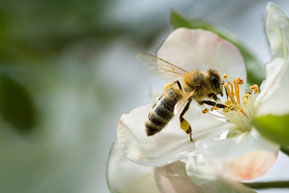How to Get Started with Backyard Beekeeping
Prep Your Hive(s) - The unfinished wood of the hive should be coated, either with paint or stain, to protect it from the elements. Only the outside of the hive should be painted. The bees will coat the inside with propolis (resin) so it is important to leave the interior unfinished. The best type of paint to use is exterior latex paint. Typically, hives in warmer climates should be painted in light or pastel colors to deflect the heat of the sun. In northern(cooler) climates, a darker color should be used, in order to absorb the warmth of the sun during winter. Bees can see color and painting each hive a different color will help the bees find their way back to their hive more easily. Have fun with this part.

Choose a Location for Your Hive(s) - There is no simple answer regarding the best place to put a hive, but most experts agree a sunny location is best. It is also important to consider safety (Is it close to a path that people walk? Are there other animals chained or penned nearby who might be spooked or stung? Can the hive be easily knocked over?) Convenient access should also be considered - the beekeeper will need to access the hives regularly. The hives should be somewhere that is easily accessible by a vehicle or cart that can help carry the full, heavy honey supers at harvest time. If possible, a location near a water source (creek, pond, etc.) for the bees would be ideal.
Install Your Bees - Bees typically come in a 3 lb. (1.5 kg) package, which contains about 10,000 bees.
Feed Your Bees - When bees are first loaded into a hive, there are usually no flowers yet in bloom, so you will need to feed your bees until there are flowers from which they can get their food. They will eat a 50/50 solution of sugar water - 1-part sugar to 1-part water. Regular white sugar that you can find at the grocery store is what should be used. There are several types of feeders available: an entrance feeder holds 1 qt. of liquid and fits into the entrance reducer. The frame feeder holds about 1 gallon of liquid and fits into the hive itself, in the place of one of the frames. A bucket feeder, which typically holds 1 or 2 gallons of liquid, is placed above the inner cover of the hive, enclosed by an empty deep hive box. The bucket feeder works best for northern climates, the frame feeder is recommended for warmer climates.
Add an Additional Deep Hive Body to prevent a swarm. Bees expand "up," not "out," since they are used to living in trees and building their colony vertically. After about one month a new hive will need more room for the bees, as the queen continues to lay eggs and new bees are continually hatching. If the bees run out of room, they will swarm, or take off with the queen to leave the hive to find more space. To prevent this, it is best to add an additional deep hive body to the hive as soon as you see the first one is filling up.
Test for Mites - Varroa mites are a common pest that can infect beehives and affect the health of your colony. Little Giant beehives come with a screened bottom and a mite board, which is a grid that can help pinpoint the size of the mite problem you might have in your hive. There are different methods to test for mites, and different treatments. For mite testing and treatment, it is best to work with your bee mentor or local beekeeping association to determine the best method for your local area and your specific hives.

Place a Queen Excluder above the Brood Box - This plastic sheet has rectangular holes that are small enough for worker bees to fit through, but too small for the larger queen bee to fit through. It is placed above the top brood box (usually the second-deep hive body) to prevent the queen from getting up into the honey supers and laying her eggs in the honey.
Add a medium (or deep) super to the hive - This is where the bees will make the honey you will extract. You will leave any honey made in lower parts of the hive for the bees to eat over the winter. The reason most people use the medium (shorter) super is because the deep hive body can weigh about 100 lbs. (45 kg) when full of honey. The medium super will weigh about 45-50 lbs. (20-22 kg), much easier to lift.
Harvest the Honey! - In July or August, the hive will be buzzing with activity and there should be honey in the super(s). The first year, there may not be very much surplus honey. The bees will need about 100 lbs. (45 kg) of honey to get through the winter and in their first year they spend a great deal of time building comb, so there is not as much time for them to do much more than make enough honey for themselves. In the second year, however, they will begin the season with comb already built, so honey production will increase.
Winterize Your Hive(s) - Inside the hive, the bees keep it at a constant warm temperature, so they should be fine during the winter. In colder climates, some people choose to wrap their hives in tar paper or cardboard wraps to insulate them. There are many different methods of winterizing hives. We recommend contacting your local beekeeper's association and asking them to help you determine the best way to winterize your hive for your local area. During the winter, you will not be opening the hive at all, so plan by getting some bee books and some beekeeping magazines to read and keep learning over the winter!